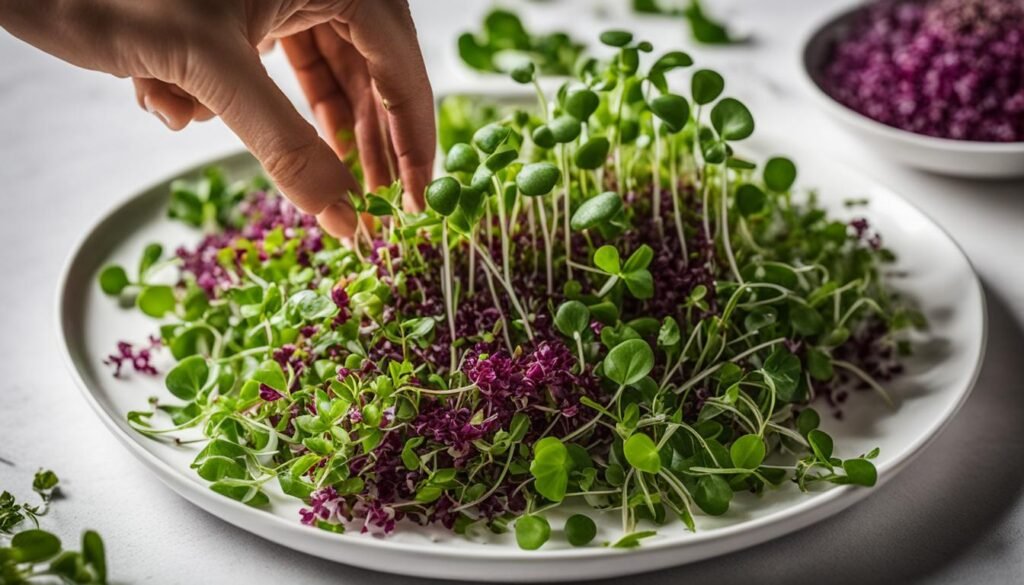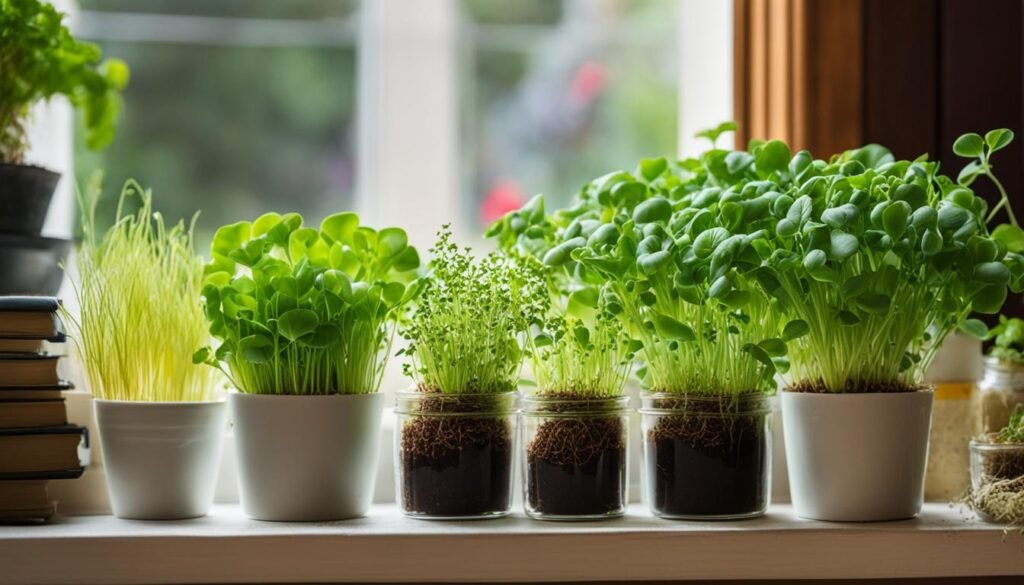Imagine a tiny power package of nutrition that can sit right on your windowsill, infusing your meals with a burst of both flavor and vitality. Welcome to the world of microgreens, the best-kept secret allies in your pursuit of a healthy lifestyle. Their tender leaves and stems are not only a visual delight but are packed with a nutritional value that eclipses their size. Making them a must-have for health aficionados everywhere.
Diving into the health benefits of microgreens consumption, you’ll find that these young vegetables pack more than just a punch of color on your plate. Often harvested just after sprouting, these greens boast concentrated levels of essential nutrients disproportionate to their diminutive statures. They’re emblematic of clean eating and urban gardening, and are poised to elevate your health without demanding much space or a green thumb. From pea to kale and radish, these microgreens for a healthy lifestyle are as versatile as they are nourishing.
Let’s explore the green giants of the plant world, uncover the best microgreens for health. Learn how this compact culinary trend can deliver a sizable impact on your wellbeing.
Key Takeaways
- Microgreens offer a high nutritional value in a small package, perfect for urban spaces.
- Incorporating the best microgreens for health into your diet can mean big gains for your overall wellness.
- Microgreens exceed mature vegetables in density of vitamins, minerals, and antioxidants.
- Easy-to-grow at home, they’re ideal for those seeking to adopt a sustainable and healthy lifestyle.
- Health benefits of microgreens consumption include improved heart health, reduced inflammation, and vital nutrient intake.
- With diverse flavor profiles, microgreens enhance both the taste and nutritive value of your meals.
Exploring the Power of Microgreens
Have you discovered the benefits of microgreens in your quest for optimal health? These tiny seedlings are not just a garnish on your plate; they are nutritional powerhouses that pack a powerful nutritional punch. Essential to both gourmet kitchens and your wellness regimen, microgreens are revolutionizing the way we think about produce and personal health.
What Are Microgreens and Their Nutritional Profile
Microgreens are young vegetable greens that fall somewhere between sprouts and baby leaf vegetables. Harvested just after the first leaves have developed, microgreens bring more than just vibrant color to your dish; they bring a concentrated dose of vitamins and minerals. The importance of microgreens for wellness cannot be overstated—they deliver essential nutrients like vitamins A, C, E, and K, along with a suite of antioxidants and minerals, all of which contribute to your optimal health and vitality.
Why Microgreens are a Smart Choice for Urban Dwellers
If you live in the city, where garden space is a rare luxury, microgreens are a savvy solution for adding home-grown nutrition to your diet. With just a windowsill or countertop, you can cultivate a variety of microgreens, ensuring you have access to fresh, nutrient-rich greens without the need for a traditional garden space. This makes microgreens an ideal choice for urbanites keen on maintaining a balanced diet and an eco-conscious lifestyle.
Eco-Friendly and Sustainable Gardening with Microgreens
- Microgreens require minimal space, reducing the need for large agricultural plots.
- By growing your own greens, you’re cutting down on the food miles associated with transporting produce to your local grocery store.
- The simplicity of their production means less packaging and, in turn, less waste.
- Through urban microgreen cultivation, you’re taking part in a sustainable gardening movement, promoting a healthier planet right from your dwelling.
In summary, embracing the cultivation and consumption of microgreens can dramatically influence your well-being and reduce your ecological footprint. They are not just a trend; they are an invitation to enhance your health and take part in a sustainable future.
The Best Microgreens for Health
Discovering the top microgreens for health can be a transformative step towards eating for optimal well-being. As you embark on the journey of growing microgreens at home, you’ll find that the process is not just about nurturing plants, but also about cultivating a healthier lifestyle for yourself and your loved ones.
Imagine your kitchen brightened by the vibrant greens of radish, arugula, and sunflower microgreens. Imagine the satisfaction as you harvest and create nourishing meals, knowing that these tiny greens pack a punch with essential vitamins and antioxidants for your health.
- Radish Microgreens – Packed with vitamins A, B, C, E, K, and minerals like calcium and magnesium.
- Arugula Microgreens – A spicy addition to any plate, rich in vitamin C and calcium.
- Broccoli Microgreens – Known for the cancer-fighting compound sulforaphane.
- Sunflower Microgreens – A hearty source of essential fatty acids and vitamin E.
- Kale Microgreens – Laden with antioxidants and fiber that support heart health.
But that’s not all. This nutritious list continues with beet, pea, spinach, and mustard microgreens—each one bursting with health-boosting properties and flavors.
- Beet Microgreens – Containing betalains which are known for their detoxification properties.
- Pea Microgreens – High in protein and a sweet taste that’s a hit with kids and adults alike.
- Spinach Microgreens – A leafy green powerhouse that’s great for bone health with high levels of calcium.
- Mustard Microgreens – Spicy and packed with vitamins for metabolism and immunity.
Eating microgreens for optimal health is simple when they’re grown right on your windowsill or balcony. They require very little space and can thrive indoors, giving you direct access to fresh nutrients year-round. So, it’s no wonder they’re recommended in over 1500 scientific studies for ramping up your daily nutrition.

Supporting Heart Health with Nutrient-Rich Microgreens
Rich in essential nutrients that are vital for maintaining a healthy circulatory system, microgreens are your heart’s allies. With high levels of vitamins and minerals, these greens are not just food—they are a regimen for longevity and vigor. Learn how to incorporate microgreens into your diet, and you’ll be taking a proactive step towards fortifying your cardiovascular health.
Fighting Inflammation and Disease with Antioxidants in Microgreens
- Radish microgreens: Packed with antioxidants to reduce oxidative stress and inflammation.
- Beet microgreens: Harness their high antioxidant capacity to protect against cellular damage.
Microgreens are a critical line of defense, harboring a spectrum of antioxidants that help keep inflammation and disease at bay, making them an invaluable addition to your daily intake.
Microgreens for Weight Management and Digestive Wellness
Not all heroes wear capes—some come in the form of leafy, vibrant microgreens. These low-calorie, nutrient-rich greens contribute to a balanced diet, making them perfect for weight management and promoting digestive health. Adding microgreens to your diet can mean reaping the benefits of a diverse array of nutrients while keeping your calorie count in check.
Best Microgreens for Health and How to Grow Them at Home
Embarking on the journey of growing microgreens at home is not just rewarding for your health, but it’s also a delightful way to enhance your culinary experiences. Imagine having a steady supply of the best microgreens for health right at your fingertips, ready to incorporate into your diet. We’ll guide you through the essentials to get started on this green endeavor.

First off, the selection of seeds is paramount. Going for organic and non-GMO seeds will ensure that your microgreens are not only nutritious but also free from unwanted chemicals. Whether you’re craving the spicy punch of radish microgreens or the tender sweetness of pea shoots, choosing high-quality seeds is the first step towards a thriving microgreen garden.
- Soil or coconut coir as growing mediums
- Adequate lighting conditions
- Consistent moisture, but not waterlogged
- Stable temperature and humidity levels
Embrace Sustainable Living with Homegrown Microgreens
Some microgreens, like the robust sunflower and delicate pea shoots, need a bit of a head start, so don’t forget to pre-soak them to kickstart germination. Once they begin to sprout, you’ll need to provide the right environment. Something as simple as placing them on a windowsill with plenty of sunlight can be sufficient, or you may consider a LED grow light for more consistent results.
When it comes to harvest time. The fruits or in this case, the leaves of your labor will be a testament to the love and care you’ve put into growing your microgreens at home. These nutrient-packed morsels are not only a spruce up for your dishes but also a connection to the very source of your nourishment, fostering a deeper appreciation for your food and its origins.
- Sunflower microgreens – Rich in protein, ideal for salads and sandwiches
- Pea shoots – High in vitamins A and C, perfect for stir-fries
- Radish microgreens – Great for detoxification, adds spice to any dish
By welcoming these microgreen growing practices into your daily life, you’ll open up a new realm of fresh possibilities. Not only will you enjoy the best microgreens for health, but you’ll also become part of a sustainable cycle of growth and consumption, all from the comfort of your home.
Ready to begin? Your kitchen counter is poised to become the bedrock of health, flavor, and environmental consciousness—a trifecta of benefits that only homegrown microgreens can provide.
How Do Fava Bean Microgreens Compare in Nutrient Content to Other Microgreens?
When comparing nutrient content, it’s essential to understand how to grow fava bean microgreens properly. Fava bean microgreens are a powerhouse of nutrients, including high levels of protein, fiber, and essential vitamins and minerals. In fact, they often outshine other microgreens in terms of nutrient density.
Conclusion
We’ve journeyed through the lush world of microgreens and unraveled the keys to a nourishing lifestyle brimming with energy and flavor. By inviting these tiny but potent greens into your daily diet. You’re not just adding a splash of color to your plate; you’re incorporating a habit that could redefine your approach to health. As we draw our exploration to a close. Let’s distill the essence of what makes these verdant treasures essential for anyone passionate about well-being and culinary innovation.
Creative Culinary Applications for Health-Boosting Microgreens
Imagine transforming your ordinary meals into a canvas of vibrant taste and loaded nutrition. Microgreens are a culinary artist’s best friend, providing a unique opportunity to creatively enhance your dishes. Sprinkle a handful of peppery arugula microgreens onto your pizza, or top off your morning avocado toast with some delicate sunflower shoots for an extra punch of flavor. But the creative culinary uses for microgreens don’t stop there. Blend them into a healthful green smoothie or stir them into a hearty quinoa salad—the options are limitless. Embracing microgreens for a healthy lifestyle is both an adventurous and a sensible journey.
Choosing the Right Seeds for Maximum Nutritional Benefit
When it comes to establishing. Your personal garden of microgreens, the act of choosing the right seeds for nutrition is paramount. Opt for organic, non-GMO seeds to assure that what you grow is as pure as it is nutrient-packed. This conscious decision not only elevates the nutritional content of your microgreens but also aligns with eco-friendly practices. By eating microgreens for optimal health, you’re also supporting sustainable agriculture—a boon for both the body and the planet. The steps you take towards integrating microgreens into your culinary routine set the foundation for a lifelong journey of health and flavor.
Source Links
- https://www.growsowgreener.co.uk/pages/the-top-5-most-nutritious-microgreens-to-grow-at-home-a-comprehensive-guide-for-the-green-fingered-gourmet
- https://microgreensworld.com/what-microgreens-to-grow/
- https://www.establishgrowers.com/post/healthiest-microgreens-to-grow

